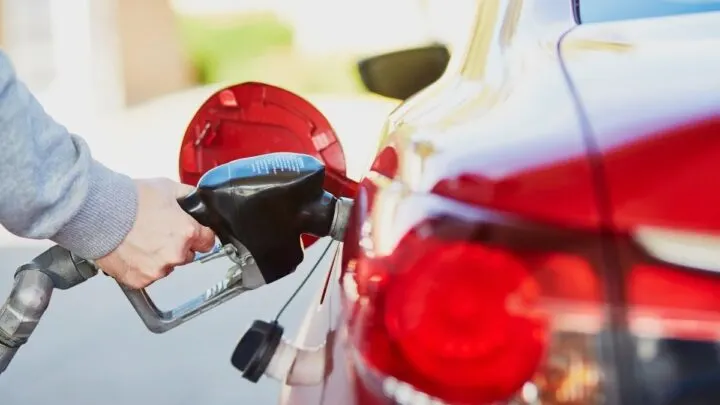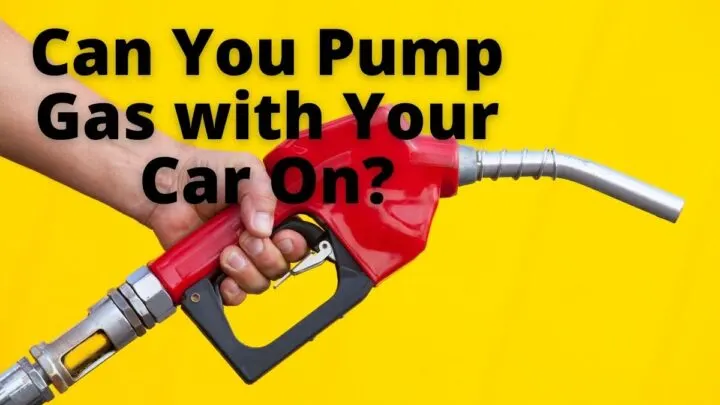The debate on whether it’s legal and safe to pump gas with your car on has been going on for decades. And given that most of us drive, we can’t avoid this debate.
Well, that’s unless you’re exclusively into driving electric vehicles. Regardless, you may want to know whether you can pump fuel into your car’s gas tank while the engine is running.
You can leave your car on while you’re pumping gas, however, it’s still safer to refuel while your car engine is turned off. Directing fuel into your gas tank is harmless, provided there isn’t a chance of a fire or sparking happening. Also, it’s technically illegal to pump gas if your car is running, meaning you definitely shouldn’t make this a common practice.
You’ll always find placards on fuel dispensers stating that you need to shut off your engine before refueling.
Today’s article looks into refueling while your car engine is running, its legality, and whether it’s safe. Let’s get going.
Is It Illegal to Pump Gas While Your Car Is On?
While you could approach refueling while your car is on from a convenience standpoint, it’s still illegal to do so in most US states that comply with the National Fire Protection Association (NFPA) and International Fire Code (IFC) regulations.
ICC’s International Fire Code states that “Smoking and open flames shall be prohibited in areas where fuel is dispensed. The engines of vehicles being fueled shall be shut off during fueling.“
Therefore, drivers should instead see pumping gas while the engine is on as more safety than a legal issue.
If found doing so, you’re liable and can face jail time when it becomes evident that your recklessness is the primary cause of a fire.
Additionally, the IFC recommends that all service and fueling stations have signs at each dispenser that state as follows:
- Smoking is prohibited around any fuel-dispensing area
- Discharge any static charges on your body before touching the fuel hose by touching a metallic surface away from the fuel nozzle
- Don’t re-enter the vehicle while it’s refueling
- If a fire starts, immediately back away from the vehicle
- Don’t fill portable fuel containers while in the vehicle. Place them on the ground before filling.
It’s illegal to refuel while the car is running in any state that abides by NFPA and ICC regulations.
A fuel station attendant is at liberty to turn off the fuel dispenser if they determine that your actions are endangering those present.
Unfortunately, most people usually assume that it’s okay to fuel with their car on, since even police officers do so in some scenarios.
There are millions of refuels across the nation daily, with the probability of starting a fire while refueling being one in a million.
Such a probability is minimal, but not impossible.
Why You Shouldn’t Pump Gas With Your Car On
As we’ve seen, it’s not only dangerous but illegal to pump gas with your car on in most states and countries across the globe.
But why is it so? Is it a matter of safety against fire hazards, or are the laws against doing so outdated?
What can happen if you fuel your car while the engine is running?
Here are reasons why you shouldn’t!
1. Presence of Static Electricity
A gallon of gasoline has the explosive power of approximately 7 sticks of dynamite. And it gets worse when a gas-related fire occurs in a gas station.
Gasoline is highly flammable, and despite many safety features in gas stations, chances of fires happening are low but catastrophic when they do happen.
One cause of gasoline fires is static electricity. No one knows the number of fires started by static electricity, but the Petroleum Equipment Institute (PEI) estimates that the figure is close to 15 cases per year.
Okay, that might seem very low, but it’s still dangerous, and you shouldn’t neglect it.
In most scenarios, fires resulting from static electricity happen when a driver pulls up at a gas station to refuel and gets into a running car while it’s still refueling.
When they step out a second time to complete their fill-up, the driver touches the seat, glass, or even their clothes, transferring static electricity to their hands.
Friction between the car’s synthetic materials creates charges that then transfer to your hands, especially during cold and dry winter months.
If you neglect the charges and go directly for the refueling, you’ll transfer the static electricity to the nozzle, leading to a spark and eventually a fire.
To avoid such a case, all you have to do is touch a metallic part such as your car’s door when leaving it.
Also, a similar case is using wireless cellphones while refueling, as it’s assumed that it leads to static electricity build-up on your hands.
2. Fires From Superheated Catalytic Converters
The role of catalytic converters in our vehicles is to clean the exhaust gasses by converting toxic pollutants and gases from the internal combustion engines to water vapor and carbon dioxide.
Superheating in catalytic converters reduces their efficiency in cleaning the exhaust gasses and may lead to fires.
One culprit of overheating catalytic converters is leaking fuel injectors, which cause unburned fuel to burn within the converter.
The excess fuel overheats the converter substrate, causing a lean burn.
Lean burns cause additional misfiring, and the build-up clogs the converter, causing it to overheat and reach above 2,000 degrees Fahrenheit.
The excess heat around the catalytic converters can ignite even the slightest drops of gasoline.
Best Practices When Pumping Gas to Avoid Ignition or an Explosion
Some of the things you should avoid doing when pumping gas to help prevent the possibility of ignition or an explosion include:
- Avoid “topping off” your gas tank. This can result in the gas being spilled.
- Avoid filling any containers other than an approved gas container.
Also, some other good tips include:
Only Use Red Fuel Cans
Fuel containers are color coded. The red is for gas, the blue is used for kerosene, and the yellow is for diesel. Green cans are only used for oil.
You should not use anything other than a gas can for holding fuel. This includes barrels, plastic bags, or other containers.
Keep Your Pets and Children Safe
You may have your children and pets in the car when it is time to get gas.
It’s best to have everyone exit the car and move away from the pump while you are fueling up.
This will prevent any accidents or issues and keep everyone safe.

Types of Static Electricity Fires That Occur at Gas Stations
A report by the NFPA issued in December 2020 shows an increasing awareness of the dangers of gas station fires across the country.
There were an estimated 4,370 reported gas and service station fires in 2018 compared to the estimated 7,860 cases in 1980. That figure represents a 44 percent decline in gas station fires.
However, the figure is the highest since 2008, and we can attribute such an increase to gas station attendants’ and drivers’ laxity.
People tend to forget or neglect a danger, especially when the chances of it happening are minimal.
Here’s a look at the percentages of the three causes of static electricity fires in gas stations
- 50%: The refueler gets back into a running vehicle while it’s refueling, fails to close the door or touch any other metallic part, and returns to remove the gas pump nozzle from the vehicle’s fuel pipe.
- 29%: The refueler unscrews the gas cap and ends up transferring the static electricity to the car. In this case, it’s the gasoline fumes and not the fuel that shall ignite.
- 21%: Some other static electricity source causes a fire.
Can Your Car Explode While Pumping Gas and Using a Cell Phone?
You will see signs posted on gas pumps throughout the country that warns against using your cell phone while you pump gas. However, you may wonder if there is really any danger in doing this. Could it really cause an explosion?
According to experts, the risk is low. While the origin of these rumors isn’t known, the truth is that cell phones are very unlikely to cause a spark that would result in a fire or explosion.
The biggest concern related to using your phone while pumping gas is a distraction – just like driving. If you are distracted, you may not pay attention to the pumping process, which can result in gas spills or other issues.
What may result in a spark and explosion is if you sit in your vehicle while your car fills up. If you re-enter your vehicle and sit in the seat, you will accumulate a static charge. This can cause a spark and an ignition.
Don’t Overfill Your Vehicle’s Gas Tank
Gas pumps will automatically shut off when your gas tank is full in most scenarios. However, some drivers would want to squeeze every bit of fuel into their gas tank.
In some cases, gasoline dispensers might be faulty and fail to detect a full tank in time, to the extent that it might start spewing fuel all over your car.
Also, overfilling your gas tank directs the gas over the vapor intake hole and into the charcoal canister.
The charcoal canister and related accessories such as the valves, sensors, and tubes can handle gasoline vapors exclusively.
Any liquid intake will cause a “check engine” state, and your car will fail any emission tests. In the end, you’ll spend thousands of dollars repairing it.
Final Remarks on Fueling Your Car With It Running
While cases of fires that result from refueling while the car is on are rare, remember that the probability of such occurring isn’t zero.
Gas station fires occur and are catastrophic, especially when not handled well.
So the answer to whether you can leave your car on while refueling is yes, you can. Is it legal? It depends on your local jurisdiction.
Regardless, consider it more of a safety concern and turn off your engine before refueling.
It doesn’t hurt to take every precaution when refueling to keep those around you safe and happy.
